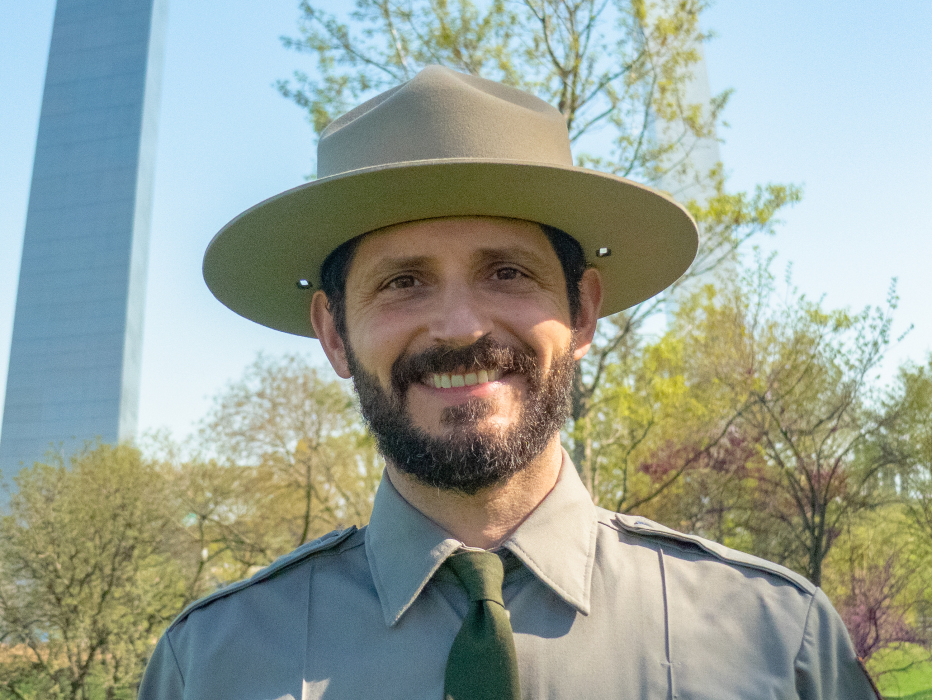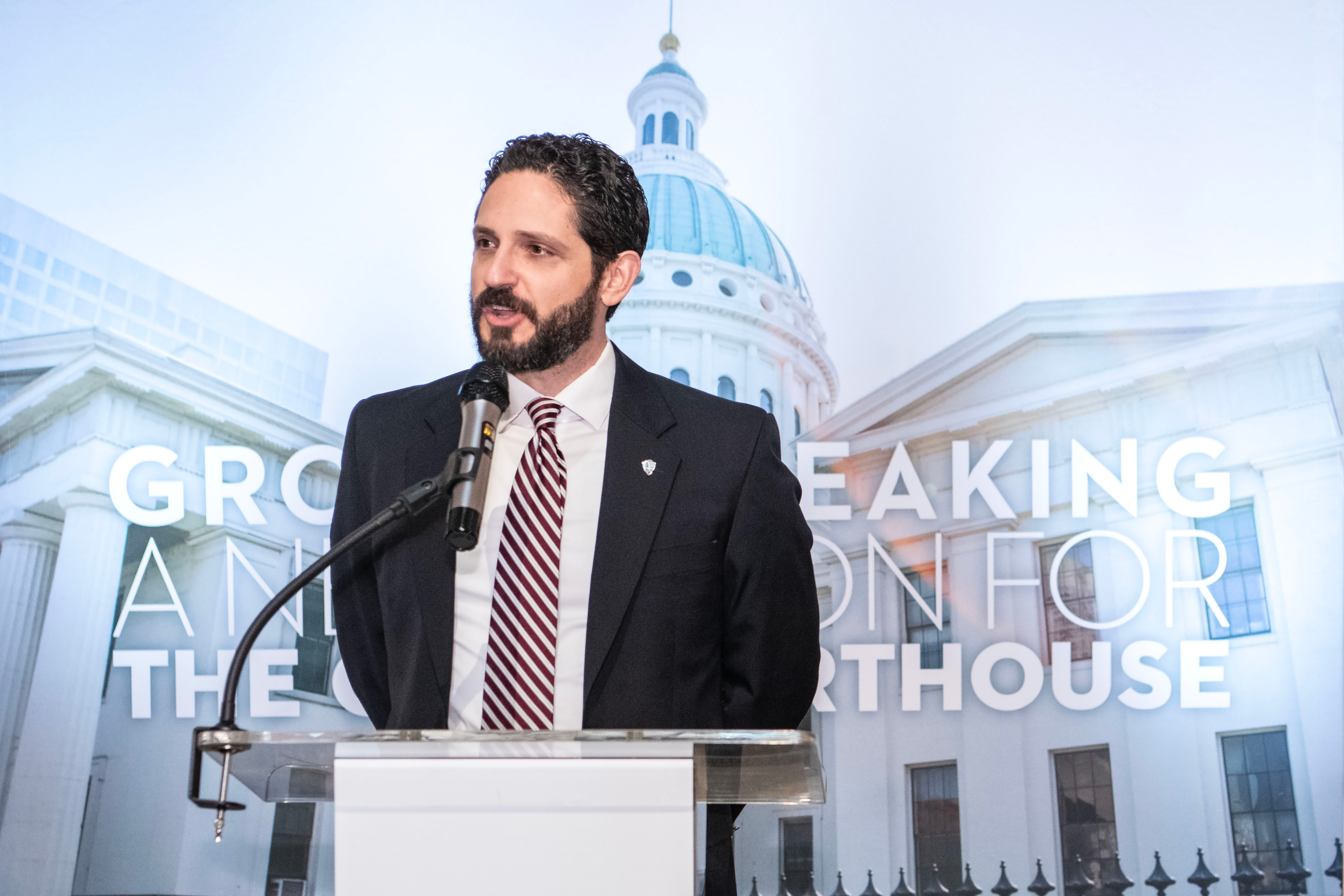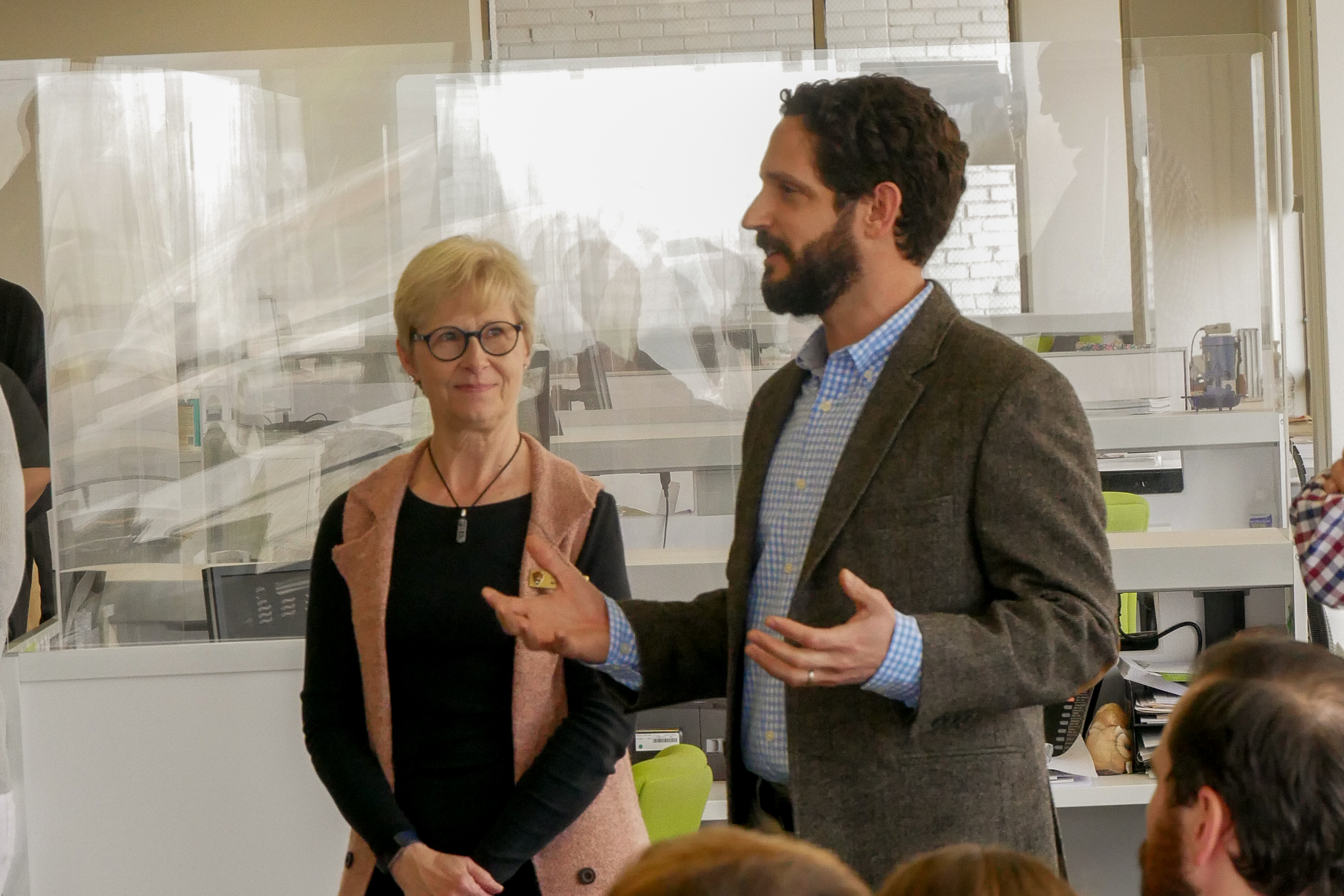Updates / News /


Updates / News /

This article was originally published in our summer 2022 newsletter, View 630'.
Not many can say they’ve spent two summers living in the side of a mountain within the bounds of a national park. But for Gateway Arch National Park’s new superintendent, Jeremy Sweat, doing that in the Great Smoky Mountains as a college student was his introduction to the National Park Service, and he hasn’t looked back since.
While studying anthropology at the University of Tennessee, Sweat enrolled in the Smoky Mountains Archeological Field School, which brought students into Great Smoky Mountains National Park to do archeology.
“We built a little tent village and lived in the park for an entire summer; we got to do all kinds of archeology at historic sites and cabins, historic Cherokee sites, prehistoric Native American sites,” Sweat said. “The next year I was selected to come back and supervise that field school as a teaching assistant, and I spent another summer in the Smokies.”
From there, Sweat joined park staff as a seasonal archeologist and the rest was history. “At the time I didn’t see myself in government; it seemed stuffy and boring, and I thought I’d go into academia or something international. I said I’ll give it a shot for a summer, and I just fell in love. I got to know the organization better and never left.”
Since that first stint in the Smokies, Sweat has gone on to forge a diverse career with the National Park Service at park, regional and national levels, from legislative specialist and policy analyst to chief of resource management at Bandelier National Monument in New Mexico to most recently regional chief of planning and compliance for the regional office in Lakewood, Colorado.
In January of 2022, he became superintendent of Gateway Arch National Park, where he oversees all park operations.
“I like urban parks — I lived in D.C. for years and that was the first place I’d lived where I had a chance to experience urban national parks,” Sweat said. “It was eye-opening to see how important those places were to the local residents and the community, both as places of learning and as places for recreation and to get away from the hustle-and-bustle of the city. So ever since then, I’ve had a place in my heart for urban parks.
“But I think more than anything, what drew me to this position is really the stories that this park tells,” he continued. “I can’t think of many places in the National Park System where we get the chance to tell so many really challenging and complex stories that are relevant to America today. Just thinking about the Arch — Western expansion was great for some people and not great for others. It meant freedom and opportunity for some, and the loss of freedom and opportunity for others. So it’s a very challenging story to tell and really important. And of course the Old Courthouse — people went there to fight for their freedom, their rights, the right to vote, women’s rights, and we’re still having a lot of those same conversations in America today.”

Mapping Out a Vision
Sweat says he aims to continue the work of the park and its partners now that the bulk of the CityArchRiver project has been completed, while gearing up for its final stage, the upcoming renovation of the Old Courthouse.
“I hate the fact that we’ve got such an incredible resource that people can’t see the inside of right now, so getting that back open and getting the interpretive materials back into the building so that we can welcome the public back is high on my list of goals,” he said.
Sweat also hopes that coming out of Covid, in the next year or two the park will return to something more like pre-2020 and be able to welcome people back to the Arch and Downtown and to be a big part of seeing this area of St. Louis come back. “Parks are never separate from their gateway communities, but one of the interesting things about urban parks — and especially here at Gateway Arch National Park — is that there is no ‘gateway community’ into the park like you have in Yellowstone or Great Smoky Mountains,” Sweat continued. “We are integrated within the city, we’re a major part of that, and I hope that as we are able to welcome more visitors and return to normal operations, that that will be a helpful thing for Downtown St. Louis.”
“We are integrated within the city, we’re a major part of that, and I hope that as we are able to welcome more visitors and return to normal operations, that that will be a helpful thing for Downtown St. Louis.”
Pulling from Perspective
Having accrued so much varied experience at such an array of national park sites, one of Sweat’s unique abilities is to see connections between the stories told here that are also told across the National Park Service.
“I think about direct connections between places like the Gateway Arch and Golden Spike National Historic Site in Utah, because they tell the story of the transcontinental railroad, which would not have happened in that same way had it not been for Lewis and Clark, had it not been for the Louisiana Purchase,” he said. “You can tie it to all kinds of things, whether it’s Sand Creek Massacre, Pecos, everything that happened in our relationship with Mexico, tribal nations — so much started here that we’re still trying to fully understand the effects of. All these stories throughout the Western United States can be tied back to things that happened here in St. Louis.
“And the Old Courthouse specifically is nationally significant,” Sweat continued. “Whether it was the signing of treaties that were later broken, or the Dred Scott case that started here and eventually went to the Supreme Court, or early women’s suffrage cases like Virginia Minor’s who fought for her right to vote almost a half century before women finally had the right to vote — this is a powerful place where so much of that national history happened. It’s important to the local community, but also important to the country.”
At the same time, it’s not lost on Sweat that St. Louisans have a distinct, “localized” affinity for the Arch, in that it represents this community to the world.
“One of the really special things about this park is that it is, without any argument, the symbol of the city and the region, on both sides of the river — it’s something people are so proud of and take so much care of, and there’s really no place I can think of exactly like that in the National Park system. This is this one iconic thing that everybody associates with St. Louis, so that’s a really special opportunity to work for and manage a place that’s so special to so many people.”
For his part, Sweat and his wife Whitney are embracing that St. Louis pride and exploring all the city has to offer.
“The amount of green space, public parks, art — we went to the Art Museum recently, which was just phenomenal, I need four more days to go back just to scratch the surface — it’s a great city,” he said. “I’ve really enjoyed the diversity of food, from all the restaurants on South Grand to Benton Park and Soulard. I’ve biked to work every day this week so far, but this has been an ideal week, we’ll see if I keep it up. I love food, I love live music, I love outdoor activity, and St. Louis definitely checks all those boxes.”

Leading a New Era of Philanthropic Partnership
Just as Sweat’s diversity of experience has broadened his perspective on the interconnectedness of national park sites across the country, so has it offered him various examples of national park philanthropic partners and conservancies — sometimes known as foundations, associations, or friends’ groups — like Gateway Arch Park Foundation.
Over the years, Sweat has worked alongside nonprofit staff and volunteers at Friends of the Smokies, the Smokies Natural History Association and Friends of Bandelier, to name a few.
He was in D.C. during the build-up to the National Park Foundation’s “Find Your Park” campaign to support the National Park Service’s Centennial in 2016, and as former NPS director Jonathan B. Jarvis sought to improve and encourage philanthropy and corporate sponsorships in the Park Service.
“Throughout my career, I’ve seen positive impacts of partnership and philanthropy pretty much everywhere I’ve been,” he said.
At the same time, when asked about particularly innovative park partnerships he’s seen, he referred back to Gateway Arch Park Foundation.
“Honestly, I’d say this is one of the most innovative. Like most NPS employees, I was aware of the CityArchRiver project long before I took this job, and I knew it was the largest public-private partnership in NPS history. And when I told people I was taking this job, a lot of people said how impressed they were and how this is now a model that other parks are looking at.’”
Sweat also talked about the Foundation’s transition into a conservancy and how important its support is for such a breadth of services — from providing ongoing professional Museum upkeep to funding educational opportunities for underserved St. Louis students to bringing tens of thousands of people to the grounds through unique events.
Sweat is leading the park’s relationship with the Foundation into a new era. He’s on the phone almost daily with the Foundation’s executive director Ryan McClure, and they are regularly exploring new and improved ways to collaborate. In May, Foundation members and corporate partners were invited to a cocktail reception at the Arch to meet Sweat in person and hear his vision for St. Louis’ hometown national park firsthand.
“To have this level of support for a park this size is really special, and I’m excited to see what lies ahead for our partnership.”
“To have this level of support for a park this size is really special, and I’m excited to see what lies ahead for our partnership.”

St. Louis has always been a city that knows the warmth of community during this time of year. YOU can continue this legacy by joining our mission to uplift our great city and its hometown national park.
JOIN TODAY to enjoy a host of member benefits and the good feeling that comes from being a part of history and enriching the lives of more than two million annual visitors and guests to downtown St. Louis.